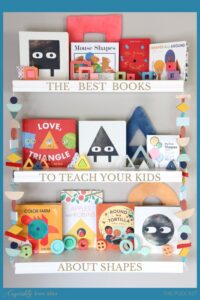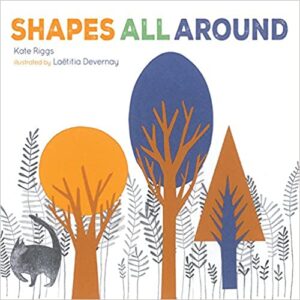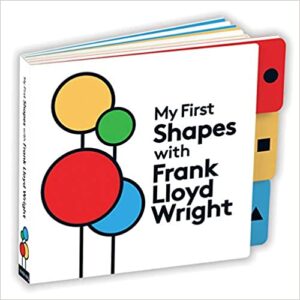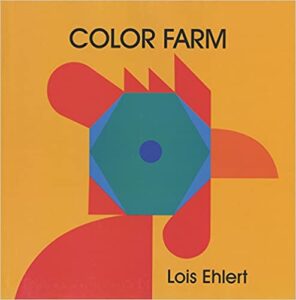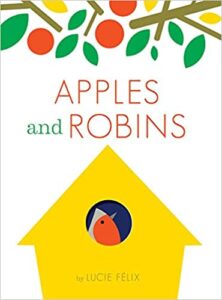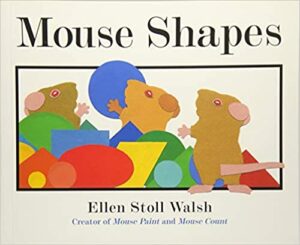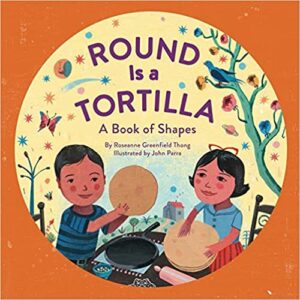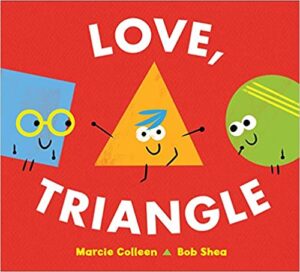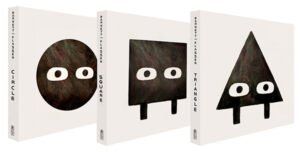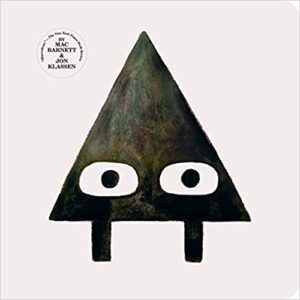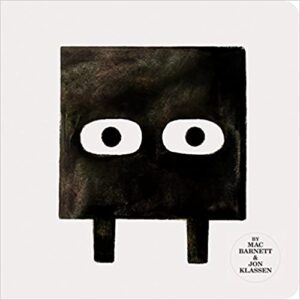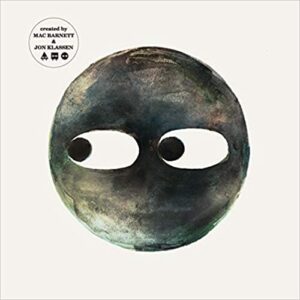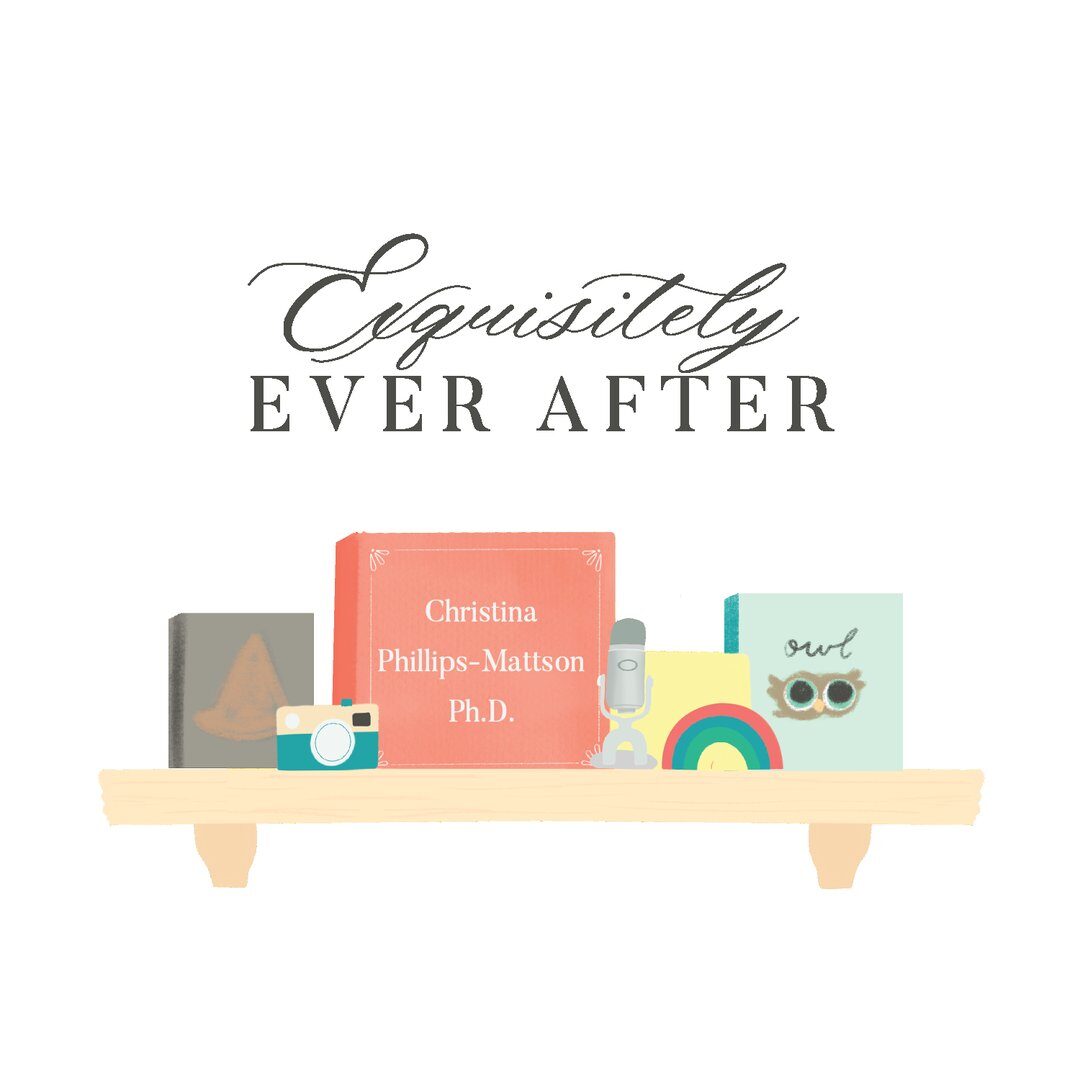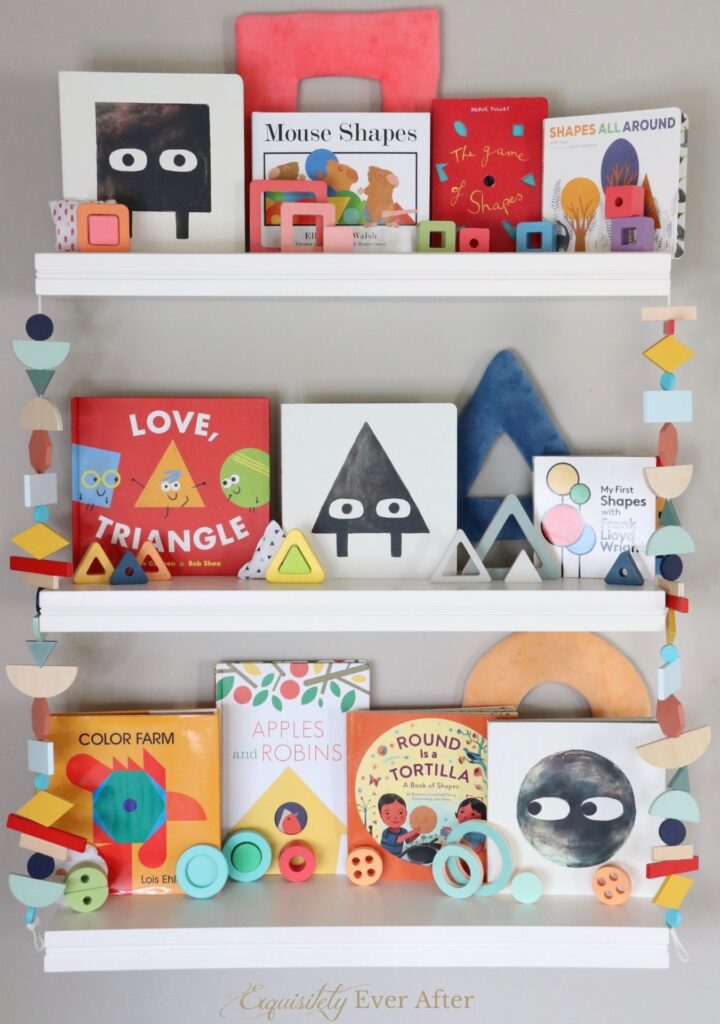
Some links are affiliate links. Please see more here.
SUMMARY: Today’s episode is all about shapes! Learning about shapes is foundational to your child’s cognitive development; by teaching your children about shapes from an early age, you are helping: to augment their communication skills, to develop their pre-reading and writing skills, to enhance their creative skills, to develop their logical thinking skills through sorting, and to give them an understanding of the basics of geometry. In this episode, we discuss concept books that will help you teach your younger children to identify and label shapes as well as books for your older children that simply have fun with shapes. I also recommend a few toys and activities that you can do with your child to supplement these shape books. Happy Reading!
Listen to the Podcast Episode:
Books Mentioned in this Episode:
*Shapes All Around by Kate Riggs, illustrated by Laëtitia Devernay
*My First Shapes with Frank Lloyd Wright
*The Game of Shapes by Hervé Tullet
Press Here by Hervé Tullet
Mix It Up! by Hervé Tullet
*Color Farm by Lois Ehlert
Color Zoo by Lois Ehlert
*Apples and Robins by Lucie Félix
*Mouse Shapes by Ellen Stoll Walsh
Mouse Paint by Ellen Stoll Walsh
*Round Is a Tortilla: A Book of Shapes by Roseanne Greenfield Thong, illustrated by John Parra
Green is a Chile Pepper: A Book of Colors by Roseanne Greenfield Thong, illustrated by John Parra
*Love, Triangle by Marcie Colleen, illustrated by Bob Shea
*Triangle by Mac Barnett, illustrated by Jon Klassen
*Square by Mac Barnett, illustrated by Jon Klassen
*Circle by Mac Barnett, illustrated by Jon Klassen
Macbeth by William Shakespeare
Note: Books marked with * are the focus books of this episode.
Activities and Toys Mentioned In This Episode:
ACTIVITIES:
Geometric Animals and Objects
Shape Search
Shape Jumping with Sidewalk Chalk
Shape Stamps or Sponge Painting
TOYS:
Janod Shape Sorter (house)
Shape Sorter (Fisher-Price)
Shape Sorter (eggs)
Triangle, Circle, Square Puzzles – ours are from Lovevery and Kiwi.co, similar here : Hape Shape Puzzle
Shape Threading Toy – ours are from Kiwi.co, similar here: Hape Threading Toy
Frankie’s Food Truck Fiasco Game
OSMO Little Genius Starter Kit
Podcast Transcript:
Hello Everybody! Today’s episode is all about shapes! We’re going to be talking about books that can help you teach your child to identify and label shapes, how you can use these books to get them to start noticing shapes in their everyday lives, and I’m also going to recommend a few toys and activities that you can do with your child to supplement the books.
So, since we have a lot of ground to cover, let’s dive right in and first talk a little bit about when your child should start learning about shapes and why learning about shapes is such an important step in your child’s cognitive development. And, just a disclaimer: it’s important to remember that there really isn’t one specific, universal developmental timeline since each child is different. Generally speaking, however, you can start teaching your child about shapes around the two year mark, give or a take a few months, although it isn’t uncommon for children who are between 2 and 3 years old to still be in the beginning stages of learning their shapes. So, basically, by two or three years of age, your child should be able to identify the majority of basic shapes (like circles, squares, rectangles, and triangles) and then, once those shapes have been solidified in their minds, you can move on to teaching them about more advanced shapes (like diamonds, stars, ovals, pentagons, hexagons, etc.). And if you’d like a real-world point of reference, I personally started teaching my kids to identify and label shapes when they were around the 19 or 20 month mark and I started with circles, squares, and triangles and then we progressed to other shapes. Luke is 22 months old now and he is very comfortable identifying and naming circles, squares, triangles, rectangles, stars, ovals, hearts, diamonds—those kinds of shapes—and he’s just mastered deciphering a pentagon from a hexagon. So, hopefully this will give you a point of reference.
Okay. So, we just talked about when and now let’s talk about why learning about shapes is an important step in your child’s cognitive development. First, and most obviously, like when children learn about colors, learning about shapes helps them to define and organize their worlds. As I mentioned in Episodes 12 and Episode 13 when we talked about colors, the ability to use colors and now shapes to describe objects will enhance your child’s ability to verbally communicate. Your child will have a richer vocabulary that will help her be understood when she tries to use descriptive phrases to explain what she wants or what she needs. So, she can say things like “May I please have that round cookie?” Or, “I need that square block for my building.”
Additionally, shapes can also be helpful as your child develops pre-reading and writing skills. Letters contain a lot of different shapes, so learning to recognize, identify, and label shapes is also an important step on the way to learning to recognize letters. The drawing and fine-motor skills that your child will hone as she learns how to draw shapes will ultimately also help her when it’s time to learn how to write letters. So, for example, being able to draw a circle is really helpful when your child is learning how to write the letters “B” or “d” or “P” or, of course, the letter “O.” And being able to draw a triangle is helpful with the letters “V” and “W” and “M.”
And speaking of drawing, the ability to draw shapes using crayons or pencils or paint or whatever, or to create shapes with things like playdoh, popsicle sticks, or pipe cleaners, or other materials will enhance your child’s creative skills. So, for example, because your child can now draw basic shapes, she will be able to better transition from drawing stick figure people to more detailed people (aka more recognizable people).
Shapes are also great as a method of sorting objects. Sorting is an important skill for children because, as I said earlier, it helps them organize the world around them, but it also helps them develop logical thinking. When children sort things, whether by shape or color or by some other method, it helps them learn to think about the various attributes of objects and how they relate to other objects.
And this relates to how learning about shapes is also foundational to your child’s math skills. By being able to look at an object and imagine how it fits into a space or how other shapes can fit within a shape (like, for example, how two triangles can be put together to form one square), your child is developing spatial visualization abilities and starting to understand geometry. So, when your child is playing with a shape sorter and flipping or turning or sliding shapes around to fit them into their proper place, she is actually learning how to problem solve and match shapes through visualization.
So, all of these things—augmenting their communication skills, developing pre-reading and writing skills, enhancing their creative drawing skills, developing logical thinking skills through sorting, and understanding the basics of geometry—are biproducts of learning about shapes and so, by teaching your child about shapes, you are directly contributing to your child’s cognitive development.
And this is where books about shapes come in. One thing that I found helpful while teaching my kids about shapes was to try to make sure I worked identifying and labeling shapes into their everyday lives so that I could check to see if they were understanding and remembering what they’d been taught. And this doesn’t have to be onerous. It can be as simple as just asking what shape the block they’re playing with is or saying, “Look at our pizza! What shape is it? … That’s right, it’s a circle! … Now what shape is this slice of pizza? Yes! It’s a triangle! The whole pizza is a circle and the slice of pizza is a triangle!” But, let’s be honest – a lot of the time we forget to insert these little lessons throughout the day because, for example, as in the case of the pizza, sometimes you just want to eat the pizza. So, including a book about shapes in your daily or nightly read aloud session, whether it is a concept book or just a book that includes a lot of shapes in it, is a really simple, effective way to make sure that you are solidifying these lessons in your child’s brain.
Okay, let’s dive into the books. The first group of books that I want to recommend are board books, so they are appropriate for toddlers and very young children, although, honestly, some of them can also be enjoyed by older children as well.
The first is called Shapes All Around by Kate Riggs and illustrated by Laëtitia Devernay. This book does exactly what its title indicates: it shows your child that there are shapes all around her in the world. The author and the illustrator demonstrate to the reader that in the natural world, shapes are everywhere, from the bright yellow circular sun in the sky, to the triangle-shaped mountains, to sea stars on the ocean floor, to the tiny hexagons in a beehive. The book ends by passing the baton to the reader by saying, “Look for shapes wherever you go.” It’s a really great, short little board book for children who are just starting to learn their shapes because each page highlights and focuses on just one shape at a time. As I mentioned in Episode 12 when we talked about colors, when it comes to learning concepts like colors and shapes, it helps to begin with books where the shapes are separated out at first, (like, there are only one or two shapes on a page) so that your child can more easily discern which shape is which.
And I like that the illustrations of this book also help to highlight just one particular shape per page. The shape itself is drawn in color while the illustrator uses pencil to draw almost everything else in black and white—and, just to note, not a harsh black-and-white, but rather soft, muted shades of graphite. So, for example, on the page that says: “Rest on a square spread beneath a tree” the square blanket is a light, spring green color while most of the trees around it are drawn in varying shades of gray and charcoal, with the exception of a few slim trees that are the same color as the square blanket; these trees are the ones drawn closest to the blanket, so it’s as if the illustrator is trying to draw your eye to it, helping you to notice the shape. She does this with each page and each shape, so, with the rust-red sea star for example, in the underwater scene, there is a school of fish that is swimming toward the star and Devernay colors in a few of them in a line in the same rust-red, as if they are pointing the way to the star. It’s very subtle, but such a clever way to reinforce this message of noticing or actively looking for shapes all around you. And thus, it’s also a great book to initiate your own shape search with your child: you can read this book with your child and then walk around your house or your yard or your neighborhood and look for shapes.
My First Shapes with Frank Lloyd Wright
Okay, moving on to our next book which is called My First Shapes with Frank Lloyd Wright. So, just a disclaimer about this book: this feels like the kind of book you’d buy in a museum shop. And by that I mean it seems more like a book that the people at the Frank Lloyd Wright museums made as a way to include children in their gift shops than a book that actually is made for children. It’s like a coffee table book for babies. It’s very Instagram-able if you know what I mean? And this always makes me skeptical if a book is going to actually land with children or if it’s just a money grab. And at first, I have to be honest and tell you that this book leaned toward the latter for me. Like, on the page that talks about half-circles and arches the narrator even says that the accompanying illustration of arches is actually the entrance to a gift shop that Mr. Wright designed. And, additionally, in some ways, this book is definitely a bit off when it comes to figuring out who its target audience is. Throughout the entire book, after identifying and having the child try to spot circles, triangles, and squares in various designs, it also talks about the ways that “Mr. Wright” as they call him used the different shapes in his architecture. For example, right after saying “This is a circle,” the next page says “Concentric circles repeat and overlap. Mr. Wright used them in his patterns a lot.” And, I mean, there’s a huge leap between teaching a small child what a circle is and then what concentric circles are and this book makes that leap in just one page. So, it has a hard time trying to stay appropriate for toddlers but also teach kids about Frank Lloyd Wright. The result is that some of this book seems a little forced. HOWEVER, despite all of this, the reason I wanted to include it in this list of best books about shapes is that, I have to say, if you can ignore the blatant marketing, this book can be really effective in teaching your child to identify circles, triangles, and squares and how they can be used in patterns and how they can fit together and how they can be used to make other shapes and so on. I like the seek-and-find aspect of this book where the narrator asks the child to find a particular number of squares in a stained-glass window or asks the child to find small, medium, and large triangles in a pattern.
BUT, the main reason I’m recommending it is that this book uses bright, bold, mostly primary colors outlined in thick black lines which makes them stand out from the page. This means that this book could actually be a really fun one for your infantsbecause, as we know from Episodes 4 and Episode 5, newborns love sharp contrasts and bright, bold colors and designs. So, because this book would really appeal to a newborn’s developing vision, it could be one of the first books you show your baby and, in this way, you can start introducing the concept of shapes early on. Even though your baby won’t truly begin learning about shapes until later, just hearing the words “circle, square, and triangle” and starting to attach their meaning to the images is great for your baby’s brain. And, as we also know from Episode 4 and Episode 5, it doesn’t really matter what you read your baby in the very beginning as much as it matters that you just read to her as often as you can. So, the fact that the text of this book is a little too advanced for its target audience won’t matter. AND, putting all of this aside, if you are a Frank Lloyd Wright fan, this book is definitely for you and even if you aren’t, it’s a fun, interesting little introduction to how shapes are used in architecture. Plus, maybe after reading it your child will achieve great renown by recreating Falling Waters with wooden blocks, who knows?
Alright. The next book I want to mention because, again, it’s a good one for toddlers and infants who are just starting to explore books is The Game of Shapes by Hervé Tullet. This book has no words, it’s simply a board book of different shaped cut-outs all layered on top of each other. So, basically, when you begin the book, you open it to see a blue page with a cutout of a circle, then you turn the page and another cutout shape, an oval, is revealed on a purple page, and then you turn that page and a cutout of a square is revealed, but also, on the left-hand side, the previous shape, the oval, is layered over the shape before that, the circle, to form another layered image. So, as you move through the book, when your child is an infant, you can name the shapes and colors for her and describe them (for example, you can say things like, “This shape is a circle, it’s round” or “This is a wavy shape, let’s trace it with your finger… Can you feel how curvy it is?”), and then, as your child gets older and more verbal, you can ask your child to name some of the shapes and colors herself. Also, because this book doesn’t have any words and the whole point of it is to explore shapes, your child can peek through the pages to spot other shapes or trace the outline of the shapes with her fingers on her own. So, it’s a really fun, tactile experience for children under two and it’s nice that Hervé Tullet created something for this age group because it’s a great introduction to his other interactive books like Press Here and Mix It Up! which I highlighted in Episode 13.
Okay. Our next book is like the advanced version of The Game of Shapes in that it is also a book of cutouts, but this book goes into more detail about the shapes and colors it highlights. And, unlike The Game of Shapes, this book has a wider age range because it’s appealing to young toddlers, but also to preschoolers. The book is called Color Farm and it was created by the artist and writer Lois Ehlert. Lois Ehlert actually has made several books in the cutout style, including Color Zoo which was a Caldecott Honor Book. The reason I chose to highlight Color Farm is just simply because my children actually both seemed to prefer it to Color Zoo and, honestly, I do, too. The reason I prefer Color Farm is this: one of the first things we do when our kids begin to speak is to teach them the names of farm animals and their sounds, and therefore, by the time our kids are learning their colors and shapes, they have usually already mastered a lot of the names and sounds of farm animals. So, Color Farm is great for helping children learn about shapes because 1) it shows these animals in a really unique, new, and engaging way which is really appealing for little kids, but also 2) because children are already familiar with farm animals they will more easily be able to recognize Ehlert’s depiction of a farm animal even though it isn’t realistically rendered, but rather it’s made out of a bunch of layered shapes. This will boost your child’s confidence in herself in addition to her just being excited to see how the cutout shapes are arranged and overlaid to make a geometric farm animal. So, anyway, I like this particular book because I think it’s a nice coming-together of many of the skills your child has already developed and many of the skills she is currently in the process of developing at this point in her life. So, while she is able to practice identifying and naming farm animals and their sounds, she can also work on identifying and labeling colors, and she can work on identifying and labeling shapes – all wrapped up in one fun book.
So I’m going to do my best to try to explain to you how this book works, but I’m also going to link the book in the shownotes like I do all the other books and I recommend you check it out online or in person because it’s kind of difficult to describe. But here it goes: The way this book works is that as you move from the beginning to the end of the book, Ehlert shows you one farm animal which is made out of layered cutouts, and as you turn each page, another animal is revealed using the same cutouts that were underneath the original. And, as you turn each page, the back of the animal image is a single cutout of a shape. For example, the first page is a rooster and then you turn the page and a square is revealed on the left-hand side so you can see how she used the square to create the rooster image, but now, on the right-hand side, there is an image of a duck. Then, when you turn the page, on the left-hand side is a cutout hexagon, but on the right-hand side there is now a chicken. Hopefully you guys can visualize this, but if you can’t, again, it’s linked in the shownotes. The book is organized in sections, so when you come to the end of a section, the final page doesn’t have a cutout, but rather it shows all of the shapes that were used to make the animal cutouts in that section and also labels each shape. This sounds complicated, but I just love the really clever way this book is put together because it becomes such a great learning tool for you to use to teach your child colors and shapes. And, as a little activity to go along with this book, you could cut out a bunch of different shapes in a bunch of different sizes and colors and have your child layer them to create their own geometric farm animals.
The next book I’d like to recommend is yet another cutout book (cutouts seem to be the dominant style of concept book for shapes), but, anyway, this one, Apples and Robins by Lucie Félix, is my favorite of the cutout books I’ve talked about so far. Even though I appreciate a straightforward concept book for its usefulness as a tool, I love it when a concept book also has a bit of a narrative to go with it. Apples and Robins has so much creativity and style in the way that it goes about achieving its goal of showing the reader that there are so many shapes that make up our everyday world. Basically, the book begins by saying: “All you need for apples are circles and the color red.” And then when you turn the page, the circle cutouts become three red apples and then the narrator says, “Summer is ending. The apples hang high on my tree, just out of reach.” So she weaves this little story about apples and robins into her demonstration of how all you need to create certain things like a ladder or a birdhouse or a lightning bolt or a basket are shapes and your imagination. I just love the compelling and creative way that Lucie Félix uses basic ordinary shapes. It’s such a lovely book and it’s almost magical the way the cutouts transform into the story’s objects. Every time we read this my kids are totally engaged and delighted by the reveal that comes with each page turn. They love to turn the page and then turn it back to examine just how she manages to create each image. And let’s be honest I am fascinated by this, too. It’s sweet, and playful, and such an immersive experience – I highly recommend this one.
Now, before I move on, one thing I would say is that, with this book, you as the parent have to do a little bit more work in that sometimes you have to pause and identify the shapes and name them for your child because they aren’t all labeled in the story. This isn’t a huge deal or anything and, in fact, I think it’s kind of nice that the author doesn’t interrupt the story to label each shape, but instead you have the option to simply read it through like a regular story or pause and talk about the shapes with your child, depending on your child’s mood. But, I just wanted to mention that it isn’t as straightforward a concept book as the ones I previously mentioned, but, for me at least, therein lies a lot of its charm.
Next up is Mouse Shapes by Ellen Stoll Walsh. This is another concept book that, like Apples and Robins, uses a narrative to help teach the child reader to identify and label shapes, although this book is actually both more straightforward in singling out and identifying shapes AND also at the same time has more of a traditional story to go along with the shape identification. Ellen Stoll Walsh is so good at this. I talked about her book Mouse Paint in Episode 13: Reading the Rainbow when I talked about books that will teach your child about color mixing. What I like about both Mouse Paint and now Mouse Shapes is that they accomplish teaching important concepts to the preschool/kindergarten age group without being just a straight-up didactic, informational book. So, anyway, if your child liked Mouse Paint or responds well to this story-based style of concept-teaching, this is an excellent choice.
In Mouse Shapes, Ellen Stoll Walsh tells a story about three little brown mice named Violet, Martin, and Fred who are hiding from a cat and they realize that they are hiding in shapes. So, they decide to make things with the shapes like a house, a tree, a sun, a wagon, a book, etc. As they create these geometric pictures, they talk about the shapes that they are using. For example, in one instance, Martin the mouse says, “A triangle and a rectangle make a tree.” But then Walsh helps to explain to your child about what constitutes a triangle by having Fred mouse say, “But these triangles are different,” and then having Violet chip in to say, “Triangles are tricky […] But any shape with three sides is a triangle.” The mice then proceed to make the cat out of the shapes, but then the real cat pounces. The mice run away, but then formulate a plan. They create three big scary mice and frighten away the cat. The book ends with the mice happily creating some geometric swiss cheese for a pretend lunch.
It’s such a fun, engaging book and my kids loved seeing how the clever mice outwit the cat by creating menacing, geometric versions of themselves. And, again, you could do the same activity that you did with Color Farm and cut up a bunch of shapes to have your child create their own menacing mice or cats or some of the other objects that the mice create in this book.
Round Is a Tortilla: A Book of Shapes
Like Mouse Shapes is to Mouse Paint, the next book I’d like to recommend is a companion book to another book I recommended before. This book is called Round Is a Tortilla: A Book of Shapes by Roseanne Greenfield Thong and illustrated by John Parra and it is a companion to Green is a Chile Pepper: A Book of Colors by the same author/illustrator pair that I talked about in Episode 12. Both of these books are targeted toward preschoolers and kindergarteners, but you can definitely read them to your toddlers, too. What I love about Round Is a Tortilla is that, again, it’s a twist on an ordinary concept book because, while it helps your child discover, identify, and label shapes, many of the settings of the book and the objects that are highlighted are Hispanic in origin. Also, although the book is in English, most of the shape objects are also written in Spanish. So, for example, squares are ventanas, rectangles are cold paletas that children enjoy in the summertime, triangles are wedges of sandías and quesadillas, and round circles are sombreros, campanas, and of course, as the book’s title indicates, tortillas.
John Parra’s illustrations are colorful and vibrant and they are done in the style of Mexican folk art, which really sets a joyful, celebratory tone. There is so much color and texture, which really brings the shapes to life. My favorite illustrations are the one that shows a busy town square and the one that shows a grandmother cooking with her grandchildren. It reminds me of all the time I spent in the kitchen with my Greek grandmother, my Yiayia, and how that tradition is now carried over to my children and their Yiayia.
I also love that this book spans a wide age range. As I mentioned, you can read it to preschoolers and kindergarteners, but also to your toddlers and have them point to the different shapes. Or, this book could also be useful to older elementary school students who are learning Spanish. There’s a glossary in the back of this book that explains the meaning and history behind many of the Spanish words that appear in the text, which is really helpful and interesting. It’s wonderful to expose our kids to a wide variety of cultures and traditions and reading books like this one is such a fun way to do that.
Okay, the last few books I’d like to recommend are books that aren’t concept books, but rather books that just have fun with shapes. I love reading books like these with my preschooler because even though he’s beyond the point of learning to identify and label shapes, it’s great to keep practicing shapes and talking about shapes by reading books that feature them.
So, the first of these books is called Love, Triangle by Marcie Colleen and illustrated by Bob Shea. This book is about a square and a circle who are best friends and who do everything together, until a new shape arrives that gets both of their attention. Triangle is bold and exciting and the two friends find themselves vying for Triangle’s attention and getting jealous of the time Triangle spends with the other shape. In an effort to mend things, Triangle invites both shapes for a playdate, but things get out of hand and Circle and Square accidentally flatten Triangle into a line in a tug of war. Square and Circle have to work together to return Triangle to his proper shape. And, when they succeed, all three shapes agree that they make quite the trio.
This is such a fun, playful way to teach a lesson about jealousy and changing friendships, which can be something that children of this age group struggle with. And I love that Triangle isn’t portrayed as a villain in this friendship triangle dilemma, which is normally the case when a friendship is challenged by a third party. Instead, Triangle recognizes the hurt that Circle and Square are causing each other due to their competition to win his attention and he takes steps to mend their relationship. This is such a great model for kids who might also find themselves in that situation and not know how to help bridge a deepening divide. Or wedge, as this book pun-ishly puts it. And speaking of puns, I love this book because, not only does it use shapes to teach a lesson about friendship, but it’s actually humorous. The text is full of puns and tongue-in-cheek humor, like when it says “Square was a bookworm while Circle liked to bounce into all the action.” Or, “Circle admired Square for all his good points,” and the accompanying illustration is a drawing of square with all of his four points labeled. And then when Triangle comes into the picture, Circle refuses Square’s offer of grilled cheese and says, “No, thank you. I’m suddenly craving pizza.” And then Triangle tells Circle about shorts that are all the rage in Bermuda. It’s funny and, as you read it, you can explain all of the little jokes and puns to your child. As I’ve mentioned before, little kids love to be in on a joke and these are really cute ones, perfect for this age group.
Triangle, Square, and Circle
Okay, finally, the last three books I would like to mention are my personal favorite shape books and they are Triangle, Square, and Circle, by Mac Barnett and illustrated by Jon Klassen. Triangle, Square, and Circle are three companion books that take place in the same world, each highlighting a particular shape while also including one or both of the other shapes in their stories. These books came out successively in 2017, 2018, and 2019, but they don’t need to be read in any particular order to be understood. So, first off, fair warning: these books aren’t for everyone. If you are looking for a wholesome book about friendship like Love, Triangle, these are not that. They’re a little bit irreverent or maybe the better word is “mischievous” because the humor is wry and sly, and the shapes aren’t necessarily modeling the best behavior, and the illustrations are hilariously weird for a children’s book. But, what can I say? I think these books are awesome and by some bizarre Barnett and Klassen alchemical process, they really connect with kids—and with adults. When I read these books to my kids, I always laugh out loud. I can’t help it. They’re so unexpectedly funny in an eyebrow-raising way. You’ll see what I mean after I tell you the plot of each book. But yes, the point is, they aren’t exactly wholesome books. Of the three, Triangle is probably the one that is the most controversial and, to be honest, the one that makes me the most uncomfortable because Triangle deliberately, premeditatively plays a sneaky trick on Square. The trick might not be exactly mean-spirited, but it’s definitely not innocent. But, here’s the thing: children’s books can have an edge to them (pun intended) because honestly children are more complex than we sometimes allow them to be when we write for them. I like that Mac Barnett and Jon Klassen refuse to talk down to kids, but instead acknowledge that children, like adults, have a lot going on inside their little minds and hearts. And just as we adults like reading stories where the characters, maybe don’t behave badly, but perhaps their behavior isn’t always motivated by being “good,” because we understand that life and people and relationships are complex, kids appreciate this, too. Sometimes little kids just want to be mischievous and this book is a great way for them to live vicariously through the shape characters and spare their own siblings and friends. So, my point is, just like you don’t turn into a murderous woman when you read Macbeth, your child is not going to turn into a sneaky frenemy because you read her the Triangle book.
Okay, without further ado, here is a quick summary of the three stories:
In the book entitled Triangle, Triangle decides to leave his house and his, I guess you’d call it his “environment” of triangles because it’s not a neighborhood, but rather a kind of barren landscape dotted with boulder-ish triangles, but anyway, he leaves his house and his triangle environment, travels through an area with shapes that are indeterminate, and gets to Square’s environment which is, of course, just like Triangle’s environment except full of squares. Triangle creeps up to Square’s doorway and pretends to “hiss” like a snake, terrifying Square, who cowers inside due to his deathly fear of snakes. Then, Triangle gives himself away by laughing too hard and Square discovers that it was Triangle who made the hissing noise. The two shapes look at each other for a moment and then Square chases after Triangle, back through the landscapes of shapes, until he gets to Triangle’s house. But, ultimately he can’t catch Triangle because his corners get stuck in the triangle-shaped door. At first Triangle thinks this is hilarious until he realizes that now his house is all dark and he’s terrified of the dark. Now it’s Square’s turn to laugh and he declares that now he’s the one who played a sneaky trick on Triangle. He claims that this was his plan all along, and the book ends by asking the reader, “But do you really believe him?”
The second book, Square, takes us to Square’s secret cave where every day he pushes a square-shaped boulder up and out of his cave and puts it onto the pile of square-shaped blocks that he brought up previously. One day,Circle floats by and sees Square’s block and says, “Square! […] You are a genius! I did not know you were a sculptor!” Square has no idea what she’s talking about but he’s obviously flattered so he goes along with it, enjoying the compliments. But then, Circle asks him to do a sculpture of her and before he can backtrack and explain, she leaves. The rest of that day and through the rainy night, Square tries to turn a square-shaped boulder into a perfect sculpture of Circle, but only succeeds in breaking the boulder to bits. He resolves to stay up all night to work on it, but promptly falls asleep. The next morning, he wakes up in a puddle and a panic because here comes Circle. Square gets ready to explain, but Circle stops short in wonderment. She floats above and looks down into the round puddle Square accidentally created and sees herself, perfectly reflected, in the water. “It is perfect,” says Circle. “It is?” asks Square. “Yes,” says Circle. And then she says again, “You are a genius,” as she floats away and the book ends, “But was he really?”
And then the third book, Circle, takes place at Circle’s waterfall. The three shape friends are going to play hide and seek, but the rules are that no one can hide behind the waterfall because it’s dark. Square agrees, but as soon as Circle’s eyes are closed, Triangle, of course, hides behind the waterfall. Circle goes in search of him and deep in the dark cave she sees a pair of eyes that she assumes are Triangle’s. She berates Triangle, asking him why he always breaks the rules, why he always spoils their fun, and why he’s such a bad friend. Each time there is no answer and, feeling sorry for calling him a bad friend, Circle apologizes. “Thanks!” says Triangle – from behind her. Circle realizes that the pair of eyes don’t belong to Triangle and Triangle then realizes that the eyes also don’t belong to Square and the two of them race out of the cave in a panic. They return to Square and tell him what happened and then the three friends wonder aloud at what kind of shape belonged to that pair of eyes in the dark. They close their eyes and each picture a shape and the book ends by asking the reader, “If you close your eyes, what shape do you picture?”
So, as I said earlier, I love these books. They are so well-paced and that perfect timing, with the pauses built into the story to let the shapes’ emotions and reactions play out, really contributes to their success at getting across a wry sense of humor. I laugh out loud every time I get to the part in Square where Square wakes up, despairing at the mess he’s made and says to himself, “What have I done? I push blocks. I do not shape them. I am not a genius.” And then abruptly with the page turn, Circle appears and says, “Hello genius! I am early.” “Oh dear,” whispered Square. That word “whispered” juxtaposed with Circle’s bald exclamation, “I am early!” just kills me.
I also love that each story is so simple, just a quick snippet of time and window into this shape world, but underneath the surface there are some big questions brewing. Like, for example, in Square, it seems like this is just a book about a happy accident. Square tries and tries to create art for Circle, but he fails to sculpt the rock into a perfect circle and so falls asleep thinking that he’s been defeated by his lack of genius. But then, when Circle comes, she assumes that the pool of rainwater Square created was intentional, that it’s conceptual art, and a reflection (pun intended) of his genius. We know (and Square knows) that it’s just a serendipitous mistake. But then we can ask ourselves and our kids the question: what makes something a work of “genius”? Is it just Circle’s perception of it? Is something inherently a work of genius or does it just depend on a critic’s subjectivity? Or how much does it depend on a critic’s deciding what is genius and what isn’t? Is the work of art itself really the site of genius, or does it just depend on our assumption of the artist’s intention when creating something? And, for that matter, since Circle mistakes Square for an artist who is creating images of himself when, in reality, he’s just doing his work, does this mean that there is art or beauty in mundane, everyday tasks? And, furthermore, are these really the questions that this book asks or am I just reading more into it because I, like Circle, think that this book is a work of art while really it’s just a book about a circle and a square and a happy accident? I’ll leave that one up to you! But the point is, these books are excellent for young children who are learning about shapes, but you could also read this book to an older child and have a really meaningful discussion about the nature of art. I love books like this that have such incredible range that you can enjoy in your family for years and years to come.
Before we move on from these books to talk about activities and toys to supplement your child’s learning about shapes, I just want to touch briefly on the illustrations because, again, in my opinion, the illustrations heavily contribute to the books’ genius. All three of these books are illustrated in such a unique way. It’s difficult to explain how the environment can be so … gritty and almost unrelentingly stark, kind of what you’d imagine if the earth had been scorched and was only just starting to grow back, like a weird post-apocalyptic landscape, but at the same time this environment is curiously charming. Also, the way Jon Klassen is able to capture the emotions and personalities of the shapes only through their eyes is truly masterful. I particularly love the illustration in Triangle where Triangle and Square literally eye each other up and you know, just by the look in their eyes, that this is the pause before a sudden burst of movement. It’s just so, so excellent. I highly, highly recommend these books for your kids ages 4 and up.
Okay, lastly, I got a bunch of messages saying that you guys really liked that I included activities and toys in the episodes about colors, so I just wanted to wrap up this episode by mentioning a few supplemental activities and toys that might be helpful to you when you start teaching your children about shapes. As far as activities, some things that I did with my kids were, first, as I talked about earlier, I cut out a bunch of different shapes and let them create different geometric animals and objects with them to go along with our readings of Color Farm and Mouse Shapes. But what you can also do is cut out a bunch of different shapes and go on a walk and have your child try to spot different things that match the shapes as you go along. Like, for example, a stop sign is a hexagon, a pine tree is a triangle, a house is a square, and so on.
Another thing I like to do with my kids is a game that we call “shape jumping” which is basically me just drawing a bunch of shapes on our driveway with sidewalk chalk and then calling out a shape and my kids run to jump on it. Super easy, involves minimum effort on my part, but my kids love it. You can also make this game a little more difficult by drawing each shape in a variety of different colors. So, for example, you could have multiple squares, each one a color of the rainbow so when you call out “purple square!” your child has to identify both the correct shape and the correct color.
And finally, another supplemental activity that you can do is sponge painting with shapes. You can buy sponges that are already precut into shapes or just cut them yourself, but either way, your child can use the sponge shapes to paint a pattern or make a scene using one particular shape or he can layer shapes to make a geometric person or animal. The possibilities are really endless and even though it’s messy, painting is always a hit with my kids and it’s really great for their brains and for their developing creativity.
There are also a bunch of shape toys that my kids and I love and I’ll put a full list in the shownotes if you’re interested, but right now, for the sake of time, I’m just going to give you my Top 5. And, by the way, I’m not, and this podcast is not, sponsored by any of these toys or companies. Nobody is paying me to recommend anything, but rather all of these toys are just things that I have personally used with my children and that I think might be helpful to you, too. So, 1) definitely a shape sorter of some kind. We have a really adorable, durable one by a brand called Janod that’s in the shape of a little birdhouse that I highly recommend and that I’ll link to, but I’ll also put some other options that we like in the shownotes as well. 2) I’d say shape puzzles are a really terrific way to practice shapes and work on motor skills. We have a bunch of these and I’ll link a lot of them, but I’d say, in general, the two types you need are: first, a chunky puzzle that has a bunch of different shapes – we have a Melissa and Doug one that is great. And, the second type is a puzzle that only focuses on 3 shapes or so in total, like a circle, triangle, and square, but each shape has pieces within each shape that are in varying sizes. I don’t know if I’m explaining this correctly but I’ll link it in the shownotes so you can see it. These kinds of puzzles are really excellent when you start teaching your child the concepts of small, medium, and large. Okay, 3) the third shape toy I’d recommend would be a threading toy where the beads that your child threads onto a string are actually different shapes. This type of shape toy can be really great for toddlers who are, of course, practicing their shapes, but also for children who are learning about patterns and working on their fine motor skills. Okay, Shape Toy Number 4) is actually a game that’s great for your preschooler or kindergartener. It’s called “Frankie’s Food Truck Fiasco” where the players take turns “filling orders” and try to be the first to deliver a 5-course meal by identifying and matching foods of different shapes while also avoiding hazards like greedy guests, pesky flies, and slippery banana peels. It’s a really fun game for this age group and my preschooler loves it. And finally, the fifth shapes toy I’d like to recommend 5) I know I mentioned Magna-Tiles in my episodes on colors, but magnatiles and other block sets are also excellent for helping your child learn about shapes and geometry. Plus, as I said before, Magna-Tiles are one of the toys that will occupy my preschooler for a very long time, which is always a plus. And just one more bonus toy since I already talked about Magna-Tiles in a previous episode: we really like the Osmo Little Genius Starter Kit for the iPad. There are these squishy, colorful sticks and rings that your child can use to create shapes and letters. And, I’m really picky when it comes to apps and anything else that uses a screen for kids, but the Osmo kit is actually really great for hands-on learning, critical thinking, and problem-solving. I’m definitely still an advocate of other non-screen methods of teaching your children about shapes, reading books and child-directed speech being my top choices, but this is 2020 so if you need a block of time where your child is occupied so that you can get some work done or do the laundry or cook or whatever else and you’re going to use a screen anyway, I think the Osmo is the way to go. So, hopefully this list is helpful to you and, as I said, I’ll link all of these things and a few other shape toys my children and I love in the shownotes.
And that’s it for this episode of the Exquisitely Ever After podcast! I hope this episode is helpful to you when you start to teach your little ones about shapes or I hope this episode gives you some ideas for books to help keep shapes front of mind for your older kids. As always, please visit the shownotes for a list of all the books and activities and toys that were mentioned today. And if you do end up reading the Mac Barnett and Jon Klassen shape books, I’d love to hear what you think about them. You can send me an email at christina@exquisitelyeverafter.com or you can dm me on Instagram at exquisitelyeverafter or leave me a comment on the blog post for this episode at exquisitelyeverafter.com/episode17. Also, I just want to say thank you so much to everyone who has subscribed to this podcast and also to those of you who have taken the time to rate and review it—I so, so appreciate it! It really has helped grow our children’s literature community this year. If you haven’t rated or reviewed this podcast and if you have a spare minute to do so, that would be awesome! Or, if you’re finding this podcast helpful, please tell a friend! You can share this podcast via text or email and word of mouth recommendations are the number one way people find us. And if you haven’t subscribed already, please do! It’s completely free!
I hope you all had a safe and healthy Thanksgiving weekend. One of the things I’m most thankful for this year is all of you and the kind, supportive community that we’re building together. You guys are just the best. I really appreciate that you took time to listen to me talk about children’s literature today! Thanks so much again everyone! Take care, keep safe, and of course, keep reading!
Pin This Episode For Later:
